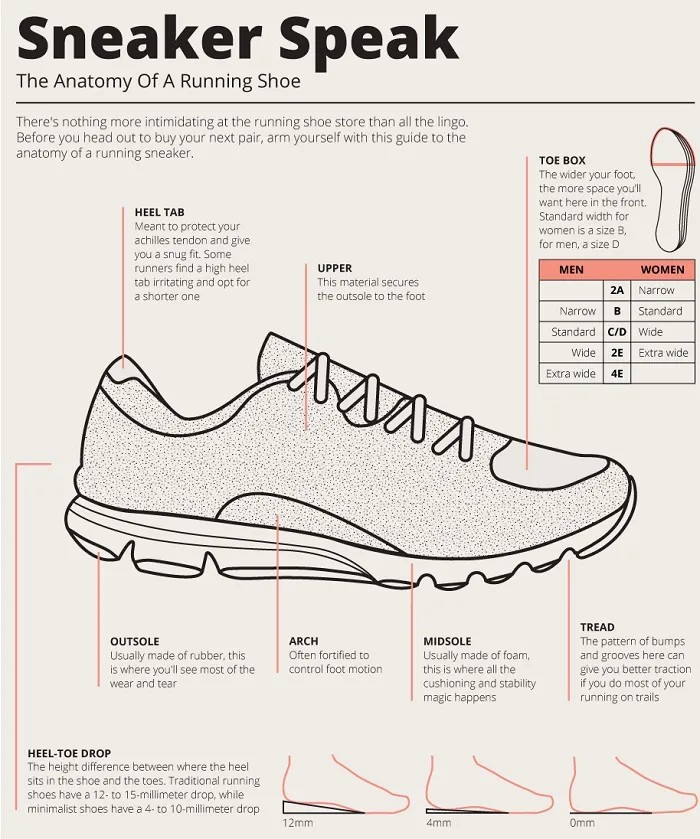Nike versus Saucony: two giants in the running shoe industry, each boasting loyal fans and innovative designs. Understanding how these brands compare, particularly regarding fit, is crucial for runners seeking optimal comfort and performance. At COMPARE.EDU.VN, we break down the key differences between Saucony and Nike running shoes, focusing on fit, features, and comparable models, to help you make an informed decision. We also discuss different aspects like foot support and running shoe cushioning.
1. Key Differences: Saucony vs. Nike Running Shoes
Nike and Saucony both offer a wide array of running shoes but distinguish themselves through distinct fit profiles and overall feel. The primary difference stems from the types of foam they use and the expanding Endorphin line from Saucony. Let’s examine the core distinctions:
1.1. Saucony Running Shoes
- Frequently noted for a snug fit, particularly suiting narrower feet with a more compact toe box.
- Offers a diverse range of heel drops, spanning from the conventional 12mm to a lower 4mm.
- Known not only for athletic footwear but also for their fashionable, everyday shoes.
- Prioritizes crafting lightweight shoes engineered for peak comfort.
- Operates a continuous Fit Tester Program to ensure shoes are always up-to-date with runners’ needs.
1.2. Nike Running Shoes
- Designed with a more tapered fit, especially in the heel and midfoot areas.
- Typically run smaller in both width and length when compared to other brands.
- Emphasizes incorporating the newest and most cutting-edge technologies to enhance running efficiency.
- Prominent across many different sports with high visibility in competitive settings.
- Maintains a dedicated following of brand enthusiasts.
It’s important to note that both brands evolve continuously, so previous experiences with one might not reflect the current models.
2. Feature Comparison: Nike vs. Saucony
Both Saucony and Nike have long histories as leaders in running shoe design, offering various technologies to enhance comfort, support, stability, and cushioning. However, they differ in fit and specific technologies.
2.1. Durability
Both brands offer shoes with comparable lifespans, although the range can vary based on factors such as runner weight and running surface.
- Saucony: Typically states their shoes last around 400 miles, which is fairly standard. Performance models like the Endorphin Pro, with a carbon fiber plate, are expected to last around 200 miles.
- Nike: The Vaporfly may only offer around 200 miles, whereas most models range from 300-500 miles.
Determining when to replace running shoes depends on factors like your gait, weight, and running terrain.
2.2. Breathability
Most modern running shoes prioritize breathability, employing different technologies and fabrics to achieve this.
2.3. Fit
Nike running shoes are often reported to run small.
Saucony shoes are often reported to run narrow, but not short in length like you sometimes find with Nike.
Neither brand typically caters to wider feet unless a wide model is selected, and neither offers a particularly large toe box like Altra Running shoes.
This graphic illustrates different components of a running shoe and their importance.
2.4. Cushioning
Saucony has largely transitioned to PWRRUN technology in their shoes, which they claim is superior to standard EVA foam.
- PWRRUN+ offers more flexibility, durability, and springiness while being 25% lighter.
- Focus remains on lighter, flexible designs for enhanced takeoff power and energy return.
Nike has been using air technology since 1977 to improve cushioning. They now use React Foam, which provides a soft and light cushion.
2.5. Stability
Nike’s stability shoes are slightly wider and designed with a curve to aid heel-to-toe transitions.
Saucony has transitioned to less aggressive stability features, ensuring the shoe doesn’t over-correct your foot.
2.6. Affordability
Saucony shoes range from $100 to $170, while Nike’s start slightly higher at $120 to $180. Prices vary based on technology and retail location.
3. Model Comparison: Nike vs. Saucony
Let’s examine top models from each brand across various categories.
3.1. Stability Running Shoes
3.1.1. Nike React Air Zoom Winflo
Utilizes React cushion and Flyknit upper for a supportive fit. It features a slightly higher arch and more toebox room than most Nike running shoes.
- 10mm drop
- 10 oz women’s, 9.9 oz men’s
- $100
The Nike Invincible offers significant bounce with stability, utilizing similar foam to the Vaporfly racing shoes.
3.1.2. Saucony Guide
The Saucony Guide provides support not only below the foot but also through the upper, enhancing stability without being overly aggressive.
- 8mm drop
- 7.8 oz women’s, 8.8 oz men’s
- $140
Check out a comparison of the Saucony Ride vs Guide.
3.2. Neutral Running Shoes
3.2.1. Nike Pegasus 40
Offers a balance of cushioning, durability, and breathability. It’s suitable for easy weekday runs or marathon training support.
- 10mm drop
- 10.9 oz men’s, 8.5 oz women’s
- $135
- Read a detailed review of the Nike Pegasus.
3.2.2. Saucony Ride or Kinvara
These are popular neutral options from Saucony.
- The Kinvara is often preferred for tempo runs or races, while the Ride is an everyday trainer.
- The Ride focuses on cushioning and support, while the Kinvara is designed for a more natural, lightweight feel.
Saucony Ride
- 8mm drop
- 7.8 oz women’s, 8.8 oz men’s
- $140
Saucony Kinvara
This has been a go-to shoe for many years due to its lightweight and low drop.
- 4mm drop
- 6.2 oz women’s, 7.2 oz men’s
- $120
- See a full review of the Kinvara 14.
3.3. Cushioned Running Shoes
3.3.1. Nike React Infinity Run
Offers React cushion and a Flyknit upper, balancing cushion with stability.
- 8mm drop
- 9.2 oz women’s, 10.7 oz men’s
- $165
3.3.2. Saucony Triumph
The Saucony Triumph is known for its plush cushioning, providing a soft and comfortable ride.
- 10 mm drop
- 8.8 oz women’s, 9.8 oz men’s
- Available in wide
- $150
3.4. Carbon Fiber Plate Shoes
3.4.1. Nike Alphafly 3
The Alphafly is designed for half marathon and marathon running, offering stability and bounce.
- Weight: 7.8 oz men’s, 5.8 oz women’s
- Heel drop: 8mm
- $275
- See current sizes and availability.
Checkout a complete Nike Alphafly 3 review.
3.4.2. Saucony Endorphin Elite
The Endorphin Elite combines lightweight foam and stack height for a propulsive ride.
- Unisex
- 8 mm heel drop
- 8.1 oz
- $250
3.5. Trail Running Shoes
3.5.1. Nike Terra Kiger
Offers minimal cushioning and is well-suited for mid-distance or faster trail running.
- Weight: 10.5 oz men’s, 8.8 oz women’s
- Heel drop: 4mm
- Available for $150
3.5.2. Saucony Peregrine
A versatile trail running shoe designed to handle a variety of terrains and conditions.
- 4mm heel drop
- 8.1 oz women’s, 9.2 oz men’s
- Available for $140
4. History of Saucony
Like New Balance, Saucony began in 1898 and by 1910 was making running spikes. The brand gained prominence in the 1970s and was featured in Runner’s World in 1979 as a top 10 running shoe. In 2009, the Saucony Kinvara changed the brand’s design philosophy, focusing on stripping shoes down without sacrificing cushion and comfort. Their guiding principles revolve around good performance, good health, and good community.
5. History of Nike Running
Nike started in 1964 as Blue Ribbon Sports and adopted the name Nike in 1971. The Nike Waffle Racer was introduced in 1972, and the brand has continued to innovate and produce new models of shoes for a variety of sports.
6. Choosing Nike or Saucony
Ultimately, choosing between Nike and Saucony depends on the fit and feel that best suits your feet. Your gait and feet can change over time, requiring adjustments in shoe selection.
It’s advisable to rotate through several pairs of shoes at once. Remember that other shoe brands may also offer the right fit for you. Shoe design can change, even within the same model, so always assess the fit when replacing a pair.
7. Maximizing Your Shoe Choice with COMPARE.EDU.VN
Choosing the right running shoe can feel overwhelming, but COMPARE.EDU.VN simplifies the process. We provide detailed comparisons, highlighting the strengths and weaknesses of different models from top brands like Nike and Saucony.
Here’s how COMPARE.EDU.VN helps you make the best decision:
- Objective Analysis: We focus on providing unbiased comparisons based on factual information and expert opinions.
- Feature-Rich Comparisons: We delve into details like cushioning technology, stability features, and fit characteristics.
- Model-Specific Insights: We offer model-specific comparisons, enabling you to see how different shoes stack up against each other.
- User Reviews & Ratings: Access reviews and ratings from fellow runners to gain real-world perspectives on shoe performance.
- Side-by-Side Comparisons: Easily compare shoes side-by-side to identify the best option for your needs.
Whether you’re seeking the plush cushioning of the Saucony Triumph or the responsive feel of the Nike Pegasus, COMPARE.EDU.VN provides the insights you need to make an informed decision.
8. Frequently Asked Questions (FAQ)
- How do Nike running shoes typically fit compared to Saucony?
- Nike running shoes often run smaller in both width and length compared to Saucony. Nike tends to have a narrower fit, especially in the heel and midfoot, while Saucony is often noted for a snug fit that suits narrower feet.
- Are Nike or Saucony better for wide feet?
- Neither brand is generally ideal for wide feet unless you specifically choose a wide model. Standard models from both brands tend to have a slimmer fit.
- What cushioning technologies do Nike and Saucony use?
- Nike uses React Foam and Air technology for cushioning, while Saucony primarily uses PWRRUN and PWRRUN+ technology.
- Which brand is more affordable, Nike or Saucony?
- Saucony shoes generally range from $100 to $170, whereas Nike shoes start slightly higher at $120 to $180.
- What are the top neutral running shoe models from Nike and Saucony?
- The Nike Pegasus 40 and Saucony Ride/Kinvara are popular neutral options.
- Which brand is better for stability shoes?
- Both Nike and Saucony offer stability shoes with features like guiderails and medial posts. The best choice depends on your specific needs and preferences.
- What is the lifespan of Nike and Saucony running shoes?
- Both brands offer shoes with comparable lifespans, generally ranging from 300 to 500 miles, though performance models may last closer to 200 miles.
- Do Nike and Saucony offer trail running shoes?
- Yes, both brands offer trail running shoes like the Nike Terra Kiger and Saucony Peregrine.
- How do I know when to replace my running shoes?
- Replace your running shoes when they reach the end of their lifespan, typically around 300 to 500 miles, or when you notice signs of wear and tear, such as reduced cushioning or breakdown of the sole.
- Where can I find detailed comparisons of Nike and Saucony running shoes?
- You can find detailed comparisons on COMPARE.EDU.VN, which offers objective analysis, feature-rich comparisons, and user reviews to help you make an informed decision.
9. Need More Help? Contact Us!
Still unsure which shoe is right for you? Don’t hesitate to reach out to our team of experts at COMPARE.EDU.VN. We’re here to provide personalized recommendations and answer any questions you may have.
Contact Information:
- Address: 333 Comparison Plaza, Choice City, CA 90210, United States
- WhatsApp: +1 (626) 555-9090
- Website: COMPARE.EDU.VN
10. Make Your Choice with Confidence
At COMPARE.EDU.VN, our goal is to empower you with the information you need to make confident decisions. We understand the challenges of comparing different options, and we’re dedicated to providing comprehensive and objective comparisons to simplify the process.
Whether you’re comparing running shoes, electronics, or financial products, COMPARE.EDU.VN is your trusted resource for making informed choices.
Visit compare.edu.vn today and discover the power of informed decision-making!

